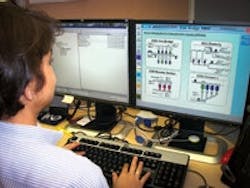About the author: Tony Paine is president and CEO of Kepware Technologies. Paine can be reached at [email protected] or 207.775.1660.
For the water and wastewater management industry, perhaps the most critical factor driving success is effective communication to and from disparate industrial devices. Without it, billing becomes inaccurate and delivery may be compromised, as different water sources could be inaccurately sent down the wrong pipes.
This situation becomes even more complex when dealing with an agricultural-based community. In this case, water is not simply used by residents; it is the engine driving the economy. Careful coordination across multiple, disparate technologies and devices must be properly established to ensure customer demands are met—and safety procedures are being followed.
Ambitious Water Reclamation
Nowhere are these issues more apparent than in the dual agricultural/residential city of Orlando, Fla. The city boasts more than 1 million residents and a large agricultural business, placing a great deal of pressure on the city’s infrastructure to successfully supply, distribute and manage the water flow. To alleviate some of this pressure, the city undertook an ambitious project to expand its wastewater treatment processes via a new integrated water reclamation plan. The ambitious project was dubbed the Eastern Regional Reclaim Water Distribution System (ERRWDS).
“Orlando is home to a growing number of residents, but we’re also experiencing a dramatic influx of new corporate headquarters to our region. While this is great for the state, it caused significant challenges in the supply, distribution and management of water,” said Guy Mecabe, wastewater systems manager for the city of Orlando.
The ERRWDS encircles central Florida and is designed to provide reclaimed water to commercial and residential customers. Water is pumped into the system from Orange County and Orlando, making it one of the largest water reuse systems in the country, as well as the first to include crop irrigation. Most notably, the system was tasked with providing approximately 28 million gal of reclaimed water per day.
The new system is fed by four different pumps. This immediately posed a challenge to the city, as the pumps were set to compete against one another, resulting in significant problems for both water pressure and maintenance. Coordination also proved difficult, as the system required operations staff from each facility to manually track and communicate water flows to ensure the system was operating correctly. The operations staff lacked the ability to provide updates on each pump station in real time, significantly hindering decision-making. Exacerbating the situation, the ERRWDS allowed the city and county to compete with one another, as each was only compensated for the amount of water delivered.
Based on this model, there were several instances in which each municipality suffered significant revenue loss for under-delivering.
A Common Problem
Orlando’s challenge is not uncommon for projects requiring real-time data visibility across disparate industrial devices, from plant control systems to enterprise information systems. Success depends on a unified view of the infrastructure with real-time updates on performance and benchmarks. For Orlando, the goal was to view key elements—such as pump status, valve positions, flows, tank levels and pressure data from each individual pump station—in a real-time and unified manner.
To make this a reality, the team created a virtual environment that simulated the network topology, consisting of Siemens’ WinCC and Kepware’s KEPServerEX servers on one domain, mirrored by the same configuration on a parallel domain. This enabled the KEPServerEX, with OPC DA and OPC UA drivers, to successfully exchange data across the separated domains. Other technology in place included Siemens programmable logic controllers (PLCs), Windows servers and Motorola Moscad remote terminal units (RTUs).
Upon installation, integrated communications were immediately established, empowering both city and county operators to view all critical elements of the system. Each entity was able to quickly create a read-only tag database built upon the others’ open-process control data.
The Wastewater Systems Group is composed of eight members responsible for maintaining the systems and networks for the city of Orlando’s three wastewater treatment facilities and 200 lift stations. The team monitors more than 25 physical and virtual servers across 200 workstations. More than 30 PLCs are maintained, with 200-plus RTUs, and four independent and redundant WinCC HMI systems. In excess of 100,000 tags are monitored on an ongoing basis.
Mecabe estimated that the integrated communications system has saved the city between five and seven man-hours each week: “Instead of the team wasting time collecting and distributing information that was already out-of-date, we could refocus them on more strategic water efficiency and management issues,” he said.
The challenge that Orlando faced is one of the most difficult obstacles for any large-scale water or waste management project. The ability to visualize and capture real-time information is critical, with all data rolled into a unified infrastructure. It is a way to stem the tide of disjointed industrial communications.
Download: Here
